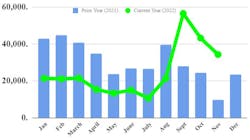A two-month surge in North American Class 8 orders ended in November, according to two trucking industry trend trackers. Both reported that orders to OEMs fell below 35,000 units last month.
But ACT Research and FTR Transportation Intelligence emphasized that order activity is way ahead of November 2021, with FTR reporting on Dec. 5 that net orders were up 254% year-over-year.
“Much of the year appears to have been slotted for production in 2023,” added Jonathan Starks, FTR’s CEO and chief intelligence officer. “That means further moderation of levels as we get into the new year. The market remains strong despite the economic uncertainties, and production still will be limited to some extent by supply chains and labor.”
See also: Class 8 orders 'robust' again in October
FTR said net Class 8 orders fell in November to 34,300 units, off October’s “robust” final total of 43,200. According to ACT, preliminary November orders to OEMs were even lower, 33,000 trucks—well below September’s above-53,000 numbers, the most for any month ever. ACT cites data from its State of the Industry: Classes 5-8 Vehicles report.
“Orders may have declined over the last two months, but compared to last year’s weak results, they are showing tremendous gains,” FTR’s Dec. 5 release stated, saying November order activity dropped 20% from October but was 254% more than November 2021. Class 8 orders now total 295,000 for the last 12 months, FTR reported. Both FTR and ACT results for November are preliminary and are subject to revision when the two data firms’ final reports are released in the middle of this month.
In its own Dec. 5 release, ACT called November’s orders “strong” and likely pushed OEM backlogs higher and extended second-half 2023 build visibility.
“OEMs having opened their order boards for 2023 more broadly, and ongoing pent-up demand—with tailwinds from strong carrier profitability and elevated fleet age—is proving resilient,” said Eric Crawford, VP and senior analyst at ACT Research.
See also: Class 8 orders soar in September to record high. Can OEMs deliver?
He added: “We continue to expect a freight recession and an eventual economic recession (mild to medium in magnitude), but OEMs at this point have clear visibility to a strong [first half 2023] (barring any unforeseen cataclysmic events).”
Meanwhile, ACT reported November medium-duty truck orders, Classes 5-7, of 21,400 units. About medium-duty orders, Crawford noted: “MD demand was solid, albeit against somewhat challenging comps. Over the past 12 months, the MD market has seen 232,700 orders booked.”
Charles Roth, FTR’s commercial vehicle analyst, had cited October as a “turning point for the Class 8 market.” Last month, he added: “While we face headwinds in the freight market, overall fleet sentiment remains optimistic. While some OEMs have indicated that they have implemented allocation plans for dealers, the retail channel is another segment of the market that has yet to be able to maintain sufficient levels of inventory due to the limited availability of supply.”
“OEMs are now filling build slots well into Q2 and the early part of Q3 2023,” Roth said a month ago. “Component shortages continue to be a week-to-week issue; however, the overall sentiment from manufacturers is optimistic that improvements will be made in the coming months and throughout the first half of next year.”





